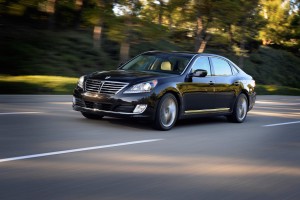The Hyundai Equus gives the South Korean automaker a place at the executive-luxury table. While it can’t compete with the best big four-door sedans from Germany, it’s a pleasant, plush luxury car that should give pause to buyers who don’t put as much weight on the badge as they do on striking value.
With a base price in the low $60,000 range, the Equus offers some of the best service and warranty coverage in the industry, and with its powerful V-8, it’s as serene and swift as a Lexus LS. It’s also one of the most heavily discounted cars in its class, with out-the-door prices often 10 to 15 percent lower than sticker price-the price of Hyundai’s recent arrival in the niche.
The Equus is unchanged for 2016, save for the addition of a hands-free trunk opener.
A 2014 once-over gave the Equus a more cohesive design, new materials, new active-safety features, and even more high-end features. That said, it’s still based on the first-generation Genesis; while that car has made strides in standard equipment, technology, and suspension configuration and tuning, the Equus awaits a redesign.
One piece of the Equus puzzle that doesn’t need changing is its brawny V-8 powertrain. The 429-horsepower V-8 is mated to a smooth-shifting eight-speed automatic transmission that you can shift manually when desired. The V-8 is equipped with direct injection, variable valve timing, and tuned variable induction. This potent powertrain can hustle the big sedan to 60 mph in about six seconds—accompanied by, as we’ve found in previous model years, a rather throaty and pleasant exhaust note. In fact, the V-8 has enough torque (376 lb-ft) to silently break the low-grip tires loose when you stomp on it from a stop; reminiscent of many an early-2000s German sedan. Fuel economy ratings for the Equus are 15 mpg city, 23 highway, 18 mpg combined.
The Equus leans toward the luxury side of the line that divides crisp handling response and a comfortable, isolated ride. The air suspension on all Equus models includes Sport and Normal modes, which now have a noticeable amount of separation. It’s quite softly sprung in Comfort mode, while its Sport mode is by no means at the Lexus LS F Sport’s level of tautness-not to mention anything floated in on a freighter from Germany or the U.K.
In terms of seating and comfort, it doesn’t quite have the vast rear-seat space of a long-wheelbase German sedan. But the Equus is quite comfortable and plushly lined, and its fit and finish are exemplary.
The Equus does quite well in IIHS crash-testing, and its most recent update included a number of additional standard safety features. Blind-spot monitors are standard, and on the Ultimate model there’s a head-up display and a multi-view camera system. A lane-departure warning system and adaptive cruise control are available as optional equipment. Nine airbags (including a driver’s knee bag), active front-seat head restraints, and Brake Assist are included across the model range.
There are two trim levels available, Signature and Ultimate. Even the Equus Signature comes as an extremely well-equipped luxury car. It packs more standard features than many models from prestige marques: standard features include HID headlamps; leather upholstery; heated-and-cooled front seats; a 12-way memory driver’s seat; steering-wheel controls; a sunroof; and adaptive cruise control. A navigation system with XM traffic and weather data, Gracenote, and 30GB storage is also included.
The limousine-like Equus Ultimate adds a rear entertainment system with dual 9.2-inch screens; rear-seat audio and climate controls; power door closures; a power rear seat; cooled rear seats; a cornering camera; power side sunshades; and a head-up display.

Leave a Reply